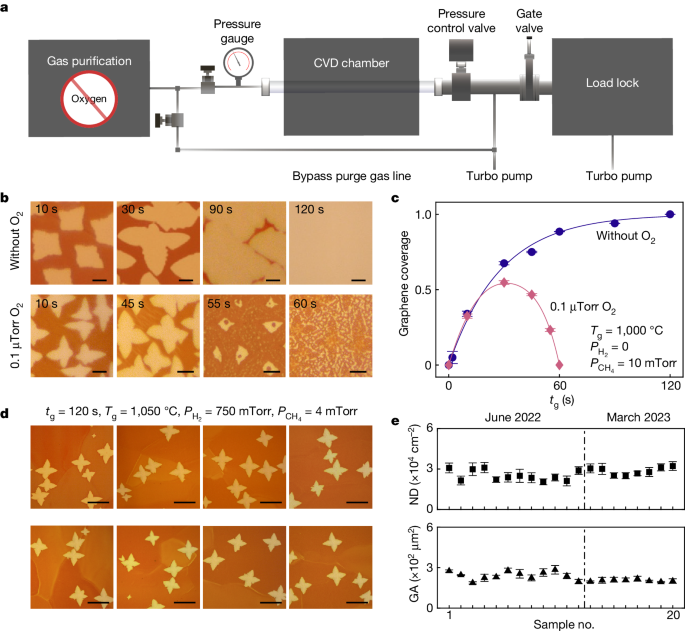Oxygen-Free Chemical Vapor Deposition Enables Highly Reproducible and High-Quality Graphene Synthesis
Core Concepts
Trace oxygen is a key factor determining the growth trajectory and quality of graphene synthesized by low-pressure chemical vapor deposition. Oxygen-free CVD enables fast, highly reproducible, and high-quality graphene growth.
Abstract
The content discusses the challenges with reproducibility and quality of graphene synthesized by chemical vapor deposition (CVD) on copper. It identifies trace oxygen as a critical factor affecting the growth and quality of CVD-grown graphene.
The key highlights are:
Oxygen-free chemical vapor deposition (OF-CVD) synthesis is fast and highly reproducible, with kinetics that can be described by a compact model.
Adding trace oxygen leads to suppressed nucleation and slower/incomplete growth of graphene.
Oxygen affects graphene quality, causing surface contamination, emergence of the Raman D peak, and decreased electrical conductivity.
Epitaxial graphene grown in oxygen-free conditions is contamination-free and shows no detectable D peak.
After dry transfer and boron nitride encapsulation, the oxygen-free graphene exhibits electrical transport behavior close to that of exfoliated graphene, including well-developed integer and fractional quantum Hall effects.
The work provides guidance for future CVD system design and operation to achieve increased reproducibility and quality of graphene, which will broadly influence basic research and applications.
Reproducible graphene synthesis by oxygen-free chemical vapour deposition - Nature
Stats
Graphene grown by oxygen-free CVD shows no detectable D peak in Raman spectroscopy.
Oxygen-free graphene after dry transfer and boron nitride encapsulation exhibits room-temperature electrical transport behavior close to that of exfoliated graphene.
A graphite-gated device made with oxygen-free graphene shows well-developed integer and fractional quantum Hall effects.
Quotes
"Oxygen affects graphene quality as assessed by surface contamination, emergence of the Raman D peak and decrease in electrical conductivity."
"Epitaxial graphene grown in oxygen-free conditions is contamination-free and shows no detectable D peak."
Key Insights Distilled From
by Jacob Amontr... at www.nature.com 05-29-2024
https://www.nature.com/articles/s41586-024-07454-5
Deeper Inquiries
How can the insights from oxygen-free CVD synthesis be extended to other 2D materials beyond graphene?
The insights gained from oxygen-free CVD synthesis of graphene can be extended to other 2D materials by understanding the role of impurities and contaminants in the growth process. Just like oxygen affects the nucleation and growth of graphene, impurities specific to other 2D materials may have similar impacts. By conducting similar studies to identify key factors influencing the quality and reproducibility of growth, researchers can tailor the CVD process for different 2D materials. Additionally, the compact model developed for oxygen-free CVD synthesis of graphene can serve as a framework for optimizing the growth conditions of other 2D materials, leading to improved quality and reproducibility.
What are the potential challenges and limitations of scaling up the oxygen-free CVD process for industrial-level graphene production?
Scaling up the oxygen-free CVD process for industrial-level graphene production may face challenges and limitations related to equipment scalability, cost-effectiveness, and process control. The initial investment required for large-scale CVD systems capable of producing graphene in commercial quantities can be substantial. Ensuring uniformity and consistency across a large area during the growth process is crucial but can be technically challenging. Controlling impurities and maintaining oxygen-free conditions on an industrial scale may also pose difficulties. Furthermore, the cost of precursor materials, energy consumption, and overall process efficiency need to be optimized for cost-effective production. Addressing these challenges will be essential for the successful industrialization of oxygen-free CVD for graphene production.
What other factors, beyond oxygen, could influence the reproducibility and quality of CVD-grown graphene, and how can they be systematically investigated?
Apart from oxygen, several other factors can influence the reproducibility and quality of CVD-grown graphene, including precursor gas purity, growth temperature, growth time, substrate quality, and process parameters. To systematically investigate these factors, a comprehensive experimental design approach can be employed. By varying one factor at a time while keeping others constant, the individual impact of each parameter on graphene growth can be studied. Statistical methods such as design of experiments (DOE) can help in analyzing the interactions between different factors and optimizing the growth conditions. Advanced characterization techniques like Raman spectroscopy, scanning electron microscopy, and electrical measurements can be used to assess the quality of graphene and identify any deviations from the desired properties. By systematically investigating these factors, researchers can enhance the reproducibility and quality of CVD-grown graphene.
0
